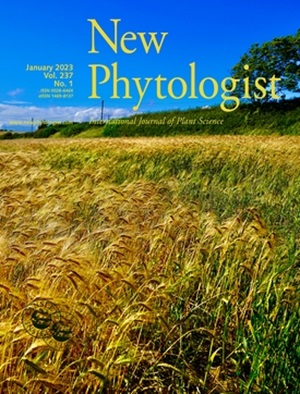Cell proliferation suppressor RBR1 interacts with ARID1 to promote pollen mitosis via stabilizing DUO1 in Arabidopsis
IF 8.3
1区 生物学
Q1 PLANT SCIENCES
引用次数: 0
Abstract
- In plants, sperm cell formation involves two rounds of pollen mitoses, in which the microspore initiates the first pollen mitosis (PMI) to produce a vegetative cell and a generative cell, then the generative cell continues the second mitosis (PMII) to produce two sperm cells. DUO1, a R2R3 Myb transcription factor, is activated in the generative cell to promote S-G2/M transition during PMII. Loss-of-function of DUO1 caused a complete arrest of PMII. Despite the importance of DUO1, how DUO1 is regulated is largely unexplored.
- We previously demonstrated that ARID1, an ARID transcription factor, stimulates DUO1 transcription.
- Here, we show that cell proliferation suppressor RBR1 interacts with ARID1 to stabilize DUO1. While the C-terminus of RBR1 is dispensable for vegetative growth, it plays a crucial role in reproductive development and facilitates interaction with ARID1. Moreover, DUO1 is a short-lived protein, ARID1 promotes the RBR1–DUO1 interaction, and RBR1 stabilizes DUO1 in a proteasome-dependent manner. Thus, RBR1 promotes DUO1-dependent PMII progression via antagonizing its repressive role in the cell cycle factors CDKA;1 and CYCB1;1.
- Collectively, we uncover that ARID1 and RBR1 act in concert to regulate DUO1 at both the transcriptional and posttranscriptional levels, balancing cell specification and cell division.
拟南芥细胞增殖抑制因子RBR1与ARID1相互作用,通过稳定DUO1促进花粉有丝分裂
在植物中,精子细胞的形成包括两轮花粉有丝分裂,其中小孢子启动第一次花粉有丝分裂(PMI),产生一个营养细胞和一个生殖细胞,然后生殖细胞继续进行第二次有丝分裂(PMII),产生两个精子细胞。DUO1是一种R2R3 Myb转录因子,在生殖细胞中被激活,促进PMII期间S-G2/M的转化。DUO1功能丧失导致PMII完全停止。尽管DUO1很重要,但DUO1是如何调控的还未被充分研究。我们之前证明了ARID1,一个ARID转录因子,可以刺激DUO1的转录。在这里,我们发现细胞增殖抑制因子RBR1与ARID1相互作用以稳定DUO1。虽然RBR1的c端在营养生长中是必不可少的,但它在生殖发育中起着至关重要的作用,并促进了与ARID1的相互作用。此外,DUO1是一个短寿命蛋白,ARID1促进RBR1 - DUO1相互作用,RBR1以蛋白酶体依赖的方式稳定DUO1。因此,RBR1通过拮抗其在细胞周期因子CDKA;1和CYCB1;1中的抑制作用,促进了duo1依赖性PMII的进展。总的来说,我们发现ARID1和RBR1在转录和转录后水平上共同调节DUO1,平衡细胞规格和细胞分裂。
本文章由计算机程序翻译,如有差异,请以英文原文为准。
求助全文
约1分钟内获得全文
求助全文
来源期刊

New Phytologist
生物-植物科学
自引率
5.30%
发文量
728
期刊介绍:
New Phytologist is an international electronic journal published 24 times a year. It is owned by the New Phytologist Foundation, a non-profit-making charitable organization dedicated to promoting plant science. The journal publishes excellent, novel, rigorous, and timely research and scholarship in plant science and its applications. The articles cover topics in five sections: Physiology & Development, Environment, Interaction, Evolution, and Transformative Plant Biotechnology. These sections encompass intracellular processes, global environmental change, and encourage cross-disciplinary approaches. The journal recognizes the use of techniques from molecular and cell biology, functional genomics, modeling, and system-based approaches in plant science. Abstracting and Indexing Information for New Phytologist includes Academic Search, AgBiotech News & Information, Agroforestry Abstracts, Biochemistry & Biophysics Citation Index, Botanical Pesticides, CAB Abstracts®, Environment Index, Global Health, and Plant Breeding Abstracts, and others.
 求助内容:
求助内容: 应助结果提醒方式:
应助结果提醒方式:


